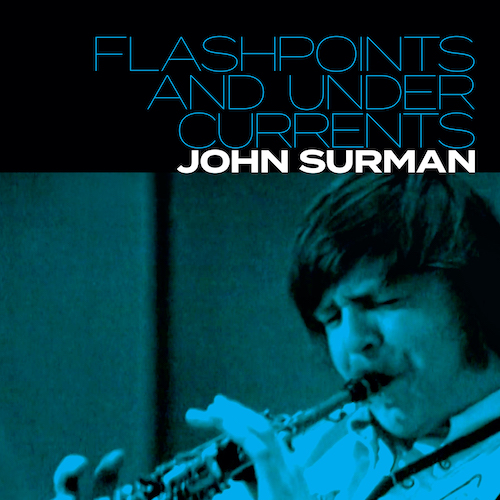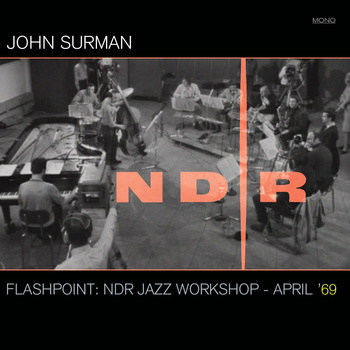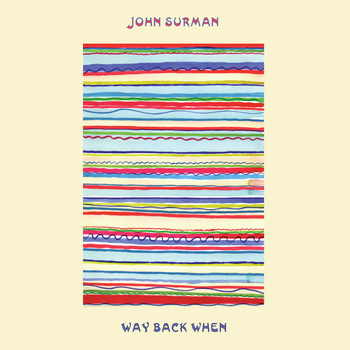For nearly 45 years, John Surman has been one of England's best known modern jazz musicians. His career began in the late 60s as both a sideman and a leader with such notable greats as John McLaughlin, Chris McGregor's Brotherhood of Breath, Terje Rypdal, Mike Westbrook, Barre Phillips, Albert Mangelsdorff, Chick Corea and many others. He began working with the ECM label in the late 1970s where he has released a string of fine work that continues to this day. Every period of his career is filled with highlights, which is why Cuneiform is exceedingly proud to release for the first time ever this amazing document of the late 60s 'Brit-jazz' scene.
Also see: The S.O.S. (John Surman - Mike Osborne - Alan Skidmore) Cuneiform Artist Page
 FLASHPOINTS AND UNDERCURRENTS RUNE 515/516 |
Recently celebrating his 80th birthday and one of Europe’s foremost jazz musicians, John Surman is a masterful improvisor, composer, and multi-instrumentalist (baritone and soprano sax, bass clarinet, and synthesizers/electronics). For nearly 60 years, he has been a major force, producing a prodigious and creative body of work that expands beyond jazz. Surman’s extensive discography as a leader and a side man numbers more than 100 recordings to date and has featured dozens of prominent artists worldwide. Surman is most popularly known for his longstanding association with the German label ECM, who began releasing Surman’s recordings in 1979. Every period of his career is filled with highlights, which is why Cuneiform is exceedingly pleased to release for the first time ever this amazing document of the late 60s 'Brit-jazz' scene. Recorded April 18, 1969 in Hamburg, Germany Flashpoints and Undercurrents press release |
 FLASHPOINT: NDR JAZZ WORKSHOP - APRIL '69 RUNE 315/316 |
"Cuneiform Records has unearthed a hidden treasure of British jazz." – Audiophile Audition "Flashpoint: NDR Jazz Workshop—April '69 is a stunning discovery. Featuring unreleased material executed by a unique ten-piece line-up of European jazz luminaries, it provides a fascinating window into the development of British saxophonist John Surman at the very beginning of his career. Capturing an international all-star ensemble working through Surman's formative concepts, this informal studio session was taped in Hamburg, Germany for the NDR Jazz Workshop, a weekly television series. Despite being recorded in mono for televised broadcast, the audio and video quality is remarkably good considering the source material. Released by Cuneiform as a double disc set, the CD contains the isolated audio tracks, while the DVD features the entire 45 minute performance as filmed, preserving snippets of illuminating in-between song banter as well." – Troy Collins, All About Jazz "For fans of 60s Brit-jazz, the band is an absolute dream team featuring the era’s most vibrant players: Alan Skidmore and Ronnie Scott on tenor saxophones, the late Mike Osborne on alto, as well as Canadian trumpeter Kenny Wheeler, South African bassist Harry Miller and the criminally under-appreciated drummer Alan Jackson. They provide a big band heft that gives themes like Surman’s Western-tinged Mayflower an orchestral lushness....The clincher is the inclusion of a DVD, which presents the original German TV show from which the cuts are taken. Clear, crisp, black-and-white footage brings the date vividly to life, Surman a long-haired 24-year-old energetically throwing himself into his solos. It offers a rare chance to witness the eyes-tight-shut intensity of Osborne, and Skidmore’s verdant mop-top is quite a sight too. As a snapshot of deep 60s jazz, British or otherwise, this is 100% gold." – Daniel Spicer, bbc.co.uk "Cuneiform Records casts once more into the well-stocked stream of German radio and television jazz broadcasts, from which they previously fished out exemplary Brotherhood of Breath releases, and reels in another impressive catch. This time, they’ve landed a superior session by John Surman and a ten-piece big band. It’s an exhilarating date of Coltrane-influenced, modal-based free jazz that been cross-fertilized with other influences and stamped by Surman’s own unique voice. The Coltrane influence is obvious in the way Surman scales mighty vertical precipices in his solos. However, lovely English meadows are tucked among these crags of notes thrusting upwards and plunging earthward; the folk music-rooted lyricism of these passages based clearly in Surman’s heritage....Surman’s band includes many of his mates from groups he’d been working with including trombonist Malcolm Griffiths, saxophonists Alan Skidmore, Ronnie Scott, and Mike Osborne, trumpeter Kenny Wheeler, bassist Harry Miller, and the tragically overlooked drummer Alan Jackson. The NDR workshop format called for German musicians to join the featured artist, so pianist Fritz Pauer and trombonist Erich Kleinschuster are in the band as well. ....The two-disc set includes a DVD of the full television broadcast in addition to the CD of the just the music. There’s no additional music, but the video is exceptionally clear and well produced, using more than one camera, and the visuals are rich in details that audio alone can’t reveal. It’s somewhat shocking to hear the intensity of Osborne’s solo issuing from such a fresh-faced, almost cherubic, young man. Miller’s hooded, sleepy eyes betray his concentration and intelligence. And there’s entertaining period detail like the groovy ’60s neck ware – Pauer’s beads, Griffiths’ kerchief and turtle neck shirt, Wheeler’s narrow tie. There are also more substantial things to be gained from watching the video, like how hard Miller plucks to get that huge sound of his...This was a committed, creative little big band, helping to establish a distinctively British style of jazz, and playing with all the power and enthusiasm it could muster. An important addition to Surman’s already impressive catalog." – Ed Hazell, Point of Departure "Any John Surman is welcome, but this is special...the music comes leaping at you from the start." – Peter Bevan, Northern Echo (UK) The NDR Jazz Workshop was a weekly show featuring all manner of jazzmen of the day. The taping of this NDR show was around the same time as Surman was recording his second album as a leader, How Many Clouds Can You See, so this is a unique chance to get an expanded view of his formative work as a leader and also at the early work of his musical compatriots who appear with him here. For this occasion, Surman led a ten-piece ensemble featuring the cream of modern British jazz players: John Surman - soprano and baritone sax, Kenny Wheeler - trumpet and flugelhorn, Alan Skidmore - tenor sax and flute, Ronnie Scott - tenor sax, Mike Osborne - alto sax, Malcolm Griffiths - trombone, Harry Miller - bass, and Alan Jackson - drums, as well as two Austrian musicians: Fritz Pauer - piano, and Erich Kleinschuster - trombone. Heard and seen on Flashpoint for the very first time since the original broadcast over 40 years ago are five great peformances, including two excellent Surman compositions that he never recorded elsewhere. High quality audio recordings from these musicians from this period are quite rare and video footage is basically non-existent. Captured in crisp, clear black and white footage and in excellent mono sound, this release is a exeptional and hugely important document that will blow the minds of Brit-jazz fans and will open the ears, eyes and minds of those who don't know the great and distinctive work of these fine musicians! Flashpoint press release |
 WAY BACK WHEN RUNE 200 |
This is a truly stupendous archival find, with broad appeal to both jazz and early fusion fans. This never before released album was recorded on October 7th, 1969 by John Surman and British jazz superstars. It is a mix between the vibrancy of late 60's uk jazz and spacey early electric jazz/rock ala "In A Silent Way"; listening to this album, you can hear that the fusion explosion is on the cusp of happening. Soprano/baritone saxophonist John Surman is one of the UK's best known jazzmen, having released 8 albums under his own name between 1968 - 1974 for mainstream labels such as Deram and Island. He was a member of John McLaughlin's final UK-based group, recording John's famous first solo album, Extrapolation with him in 1969, six months before recording Way Back When. Since the late 1970's, he has mostly recorded for the ECM label, recording dozens of albums as either the leader or as a sideman. "In mid-October, 1969, I left the UK to meet up with bassist Barre Phillips and drummer Stu Martin to begin working with them as "The Trio". Before I left however, a few close friends and I held a sort of 'farewell' session in Tangerine Studios in London. On hand were drummer John Marshall, electric pianist John Taylor and Brian Odgers on bass guitar - later Mike Osborne appeared with his alto and joined us. Shortly after I left England, the studios closed down and, although a few test pressings were made, the original tapes got lost in the general confusion. Much to my surprise the masters had survived and were uncovered in 2003...what you are hearing accurately reflects the sound of the sixties...it offers genuine insight into some of the musical directions that were being explored at the end of that swinging decade in the UK." – John Surman Way Back When press release |
PRESS RELEASES
Flashpoints and Undercurrents press release
Flashpoint press release
Flashpoint press quotes
Way Back When press release
Way Back When press quotes
